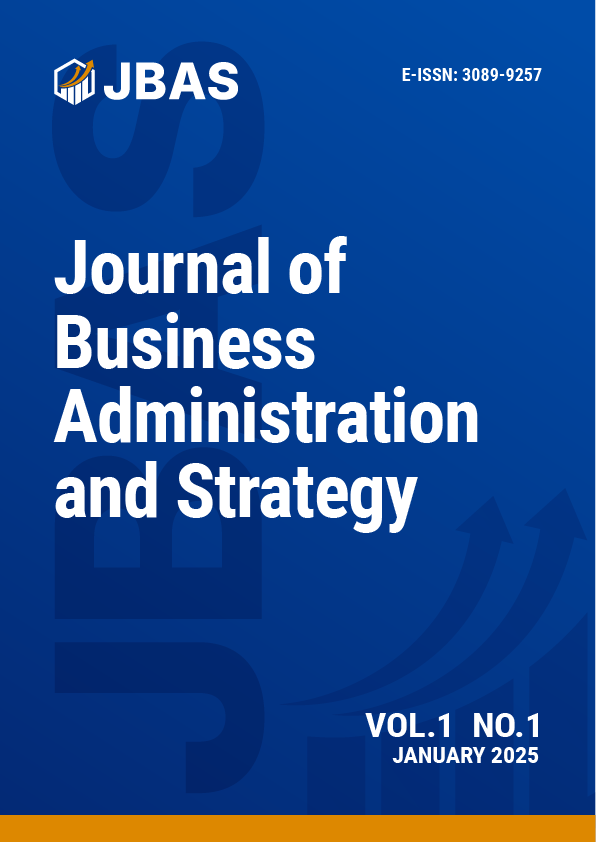The Effect of Inflation and Firm Size on Profitability in Banking Companies Listed on The Stock Exchange
DOI:
https://doi.org/10.58290/jbas.v1i1.19Keywords:
Inflation, Firm Size, ProfitabilityAbstract
This study analyzes the effect of Inflation and Firm Size on Profitability in Banking Companies listed on the Indonesia Stock Exchange. The research method used is multiple linear regression analysis, which is to determine the effect of two independent variables on one dependent variable which is then carried out t hypothesis test and F hypothesis test to determine the significance level of the effect. The population of this study is the financial statements of Banking Companies listed on the Indonesia Stock Exchange and samples taken using purposive sampling techniques so that the samples taken start from the 2019-2023 period. Based on the results of the study, it shows that simultaneously and partially Inflation and Firm Size have a positive and significant effect on Profitability. The coefficient of determination is 36.3% and the remaining 63.7% is another variable that also affects profitability but is not examined. As for partial Inflation has a greater influence than Firm Size.
Downloads
References
Ayunda, B., & Praja, N. U. H. (2018). The effect of Firm size, capital adequacy ratio (CAR), loan to deposit ratio (LDR), and non-performing loans (NPL) on profitability in foreign exchange national private commercial banks listed in Indonesia for the period 2012–2016. Journal of Management Science (JIM), 7(1).
Boediono. (n.d.). Macroeconomics: A synopsis series of introductory economics. BPFE.
Hartono, J. (2008). Portfolio theory and investment analysis. BPFE.
Houston, J. F., & Brigham, E. F. (2010). Fundamentals of financial management (3rd ed.). Salemba Empat.
Irham. (2011). Analysis of financial statements. Alfabeta.
Rahardja, R., & Manurung, M. (2008). Introduction to economics. LPFE-UI.
Sartono, A. (2010). Financial management: Theory and application (4th ed.). BPFE.
Sudana, I. M. (2011). Financial management. Erlangga.
Sugiyono. (2015). Qualitative quantitative research methods. Alfabeta.
Sugiyono. (2017). Statistics for research. Alfabeta.
Sukirno, S. (2008). Macroeconomics: An introductory theory (3rd ed.). PT RajaGrafindo Persada.
Torang, S. (n.d.). Organization and management (1st ed.). CV Alfabeta.
Downloads
Published
How to Cite
Issue
Section
License
Copyright (c) 2025 Susi Nofitasari, Risa Haruman Putri

This work is licensed under a Creative Commons Attribution-ShareAlike 4.0 International License.
All articles published in the Journal of Business Administration and Strategy are licensed under the Creative Commons Attribution-ShareAlike License (CC BY-SA). This license allows others to share, adapt, and build upon the work, even for commercial purposes, as long as they credit the original creation and license their new creations under the identical terms.
By submitting and publishing with the Journal of Business Administration and Strategy, authors agree to the following terms:
Ownership and Copyright
Authors retain copyright and grant the journal the right to first publication. The work will be simultaneously licensed under the Creative Commons Attribution-ShareAlike License (CC BY-SA), ensuring continued free and open access to the research.
Attribution Requirements
When reusing or redistributing the published material, proper attribution must include:
- Citation of the original article.
- Mention of the journal name and publication date.
- A link to the published work and the license details.
ShareAlike Terms
Any derivative works based on the original must be distributed under the same license (CC BY-SA).
Open Access
The Journal of Business Administration and Strategy is dedicated to open access, providing free and unrestricted access to all published articles without subscription fees or other access barriers.
Author Warranties
By submitting the manuscript, authors warrant that:
- The work is original and has not been published elsewhere.
- All co-authors consent to publication.
- The work does not infringe on any copyright, trademark, or proprietary rights.
No Additional Restrictions
Authors and readers are not permitted to impose legal terms or technological measures that legally restrict others from doing anything the license permits.








